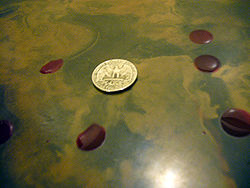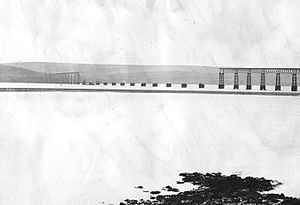- Forensic photography
-
Forensic photography, sometimes referred to as forensic imaging or crime scene photography, is the art of producing an accurate reproduction of a crime scene or an accident scene using photography for the benefit of a court or to aid in an investigation. It is part of the process of evidence collecting. It provides investigators with photos of victims, places and items involved in the crime. Pictures of accidents show broken machinery, or a car crash, and so on. Photography of this kind involves choosing correct lighting, accurate angling of lenses, and a collection of different viewpoints. Scales, like items of length measurement or objects of known size, are often used in the picture so that dimensions of items are recorded on the image.
Contents
Methods
Crime or accident scene photographers usually capture images in color but also in black and white. The photograph of the skid mark was made during reconstruction at the accident scene to show how and why the ladder had slipped and caused a serious injury to the user. Color pictures are generally preferred because color may be an important aspect of the trace evidence, for example. Thus traces of paint or dye on a piece of evidence may be crucial to linking the evidence with a crime or accident.
Various forces and different countries have different policies in regards to 35 mm film or digital photography. There are advantages and disadvantages to both. Conventional film photographs, even using disposable cameras, have a high resolution, enabling great enlargement should details in a picture need closer examination. Pictures from surveillance cameras are a growing source of evidence for courts, as are pictures taken by bystanders on mobile phones. The former are being used increasingly at accident blackspots, and bystanders may take pictures of events when no police officer or investigator is present, but yet may be critical to a case. Digital photographs usually have an automatic date and time marker on each image, so that authenticity can be verified. Conventional photographs without such marks must be authenticated by the photographer, usually in a witness statement. Pictures of the relative position of objects (as in a Palimpsest) can establish a sequence of events at a crime or accident scene. Due to continued advances in digital technology and software, digital single-lens reflex (DSLR) cameras are increasingly being used by law enforcement agencies.
Fit for court
The images must be clear and usually have scales. They serve to not only remind investigators of the scene, but also to provide a tangible image for the court to better enable them to understand what happened. The use of several views taken from different angles helps to minimise the problem of parallax. Overall images do not have scales and serve to show the general layout, such as the house where the murder is thought to have occurred. Context images show evidence in context, like how the knife was next to the sofa. Close up images show fine detail of an artifact, such as a bloody fingerprint on the knife.
Road traffic incident (RTI) photographs show the overall layout at the scene taken from many different angles, with close-ups of significant damage, or trace evidence such as tire marks at a traffic collision. As with crime scene photography, it is essential that the site is pristine and untouched as far as is possible. Some essential intervention, such as rescuing a trapped victim, must be recorded in the notes made at the time by the photographer, so that the authenticity of the photographs can be verified.
As with all evidence a chain of custody must be maintained for crime scene photographs. Sometimes a CSI (forensic photographer) will process his/her own film or there is a specific lab for it. Regardless of how it is done any person who handles the evidence must be recorded. Secure Digital Forensic Imaging methods may be applied to help ensure against tampering and improper disclosure.[1] Accident scene pictures should also be identified and sourced, police photographs taken at the scene often being used in civil cases.
Analysis of historic photographs
Crime or accident scene photographs can often be re-analysed in cold cases or when the images need to be enlarged to show critical details. Photographs made by film exposure usually contain much information which may be crucial long after the photograph was taken. They can readily be digitised by scanning, and then enlarged to show the detail needed for new analysis. For example, controversy has raged for a number of years over the cause of the Tay Bridge disaster of 1879 when a half-mile section of the new bridge collapsed in a storm, taking an express train down into the estuary of the river Tay. At least 75 passengers and crew were killed in the disaster.
The set of photographs taken a few days after the accident have been re-analysed in 1999-2000 by digitising them and enlarging the files to show critical details. The originals were of very high resolution since a large plate camera was used with a small aperture, plus a small grain film. The re-analysed pictures shed new light on why the bridge fell, suggesting that design flaws and defects in the cast iron columns which supported the centre section led directly to the catastrophic failure. Alternative explanations that the bridge was blown down by the wind during the storm that night, or that the train derailed and hit the girders are unlikely. The re-analysis supports the original court of inquiry conclusions, which stated that the bridge was "badly designed, badly built and badly maintained".
See also
- Forensic engineering
- Forensic materials engineering
- Forensic polymer engineering
- Forensic science
- Photography
- History of forensic photography
- Skid mark
- Trace evidence
References
- ^ Lawrence Memorial Hospital sexual assault exam room with SDFI system
- Introduction to Forensic Engineering (The Forensic Library) by Randall K. Noon, CRC Press (1992).
- Forensic Engineering Investigation by Randall K. Noon, CRC Press (2000).
- Forensic Materials Engineering: Case Studies by Peter Rhys Lewis, Colin Gagg, Ken Reynolds, CRC Press (2004).
- Peter R Lewis and Sarah Hainsworth, Fuel Line Failure from stress corrosion cracking, Engineering Failure Analysis,13 (2006) 946-962.
- Peter R. Lewis, Beautiful Railway Bridge of the Silvery Tay: Reinvestigating the Tay Bridge Disaster of 1879, Tempus, 2004, ISBN 0-7524-3160-9.
External links
- An online course
- Westchester Police site
- Museum of failed products
- The journal Engineering Failure Analysis
Categories:- Photography by genre
- Forensic disciplines
Wikimedia Foundation. 2010.




